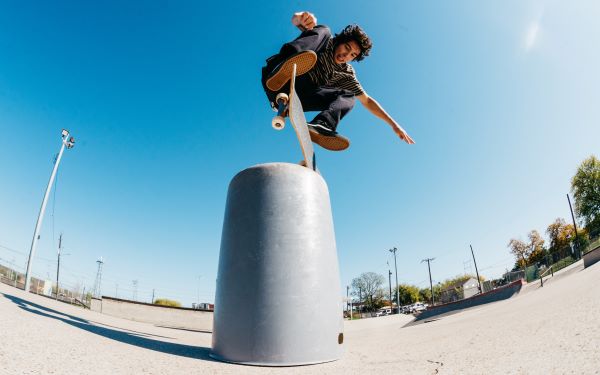Please note: As an Amazon Associate I earn from qualifying purchases. I also work with other affiliate partners and may be compensated from the links below. Details here.
Why Are My Action Shots Blurry? Reasons for Blurry Sports Photos and How to Fix It (Fast)

Welcome to my guide on blurry sports photos and how to fix that!
Let’s face:
Action photography, while rewarding, is a challenging type of photography to master. It takes knowledge and experience to take amazing action shots, like those taken at the Tour de France or Olympic games events.
But as an amateur/hobby photographer you’ll notice that your sports photos end up being terrible and you don’t understand the root problem.
The most common reason for blurry action shots is movement. When a camera shutter opens, the sensor captures light and sends it through the lens to be projected onto film or digital media. This process takes time, so even if you’re standing still while shooting an object in motion, it will appear blurry on your photo.
I know that sometimes, professionals use motion blur to add drama to photos, but at times when you don’t really need these effects, it can get quite annoying!
With that being said, I will share with you:
- the reasons why pictures get blurry
- how to stop taking unsharp photos
- how to fix unclear images
…and many other things you need to know about action shots!
Let’s start, shall we?
What Are Action Photos?
Like I mentioned earlier, action photography is one of the most difficult styles to master, yet it can be some of the most rewarding.
With so many subjects to photograph in a day, it’s important for photographers to be quick and intuitive to know which moments are worth capturing.
Action shots are very popular for one very good reason: they are interesting!
Unlike the usual portraiture and landscape scenes, these shots depict motion despite being completely frozen in frame. It’s like freezing motion in time so that everyone can pause and appreciate its beauty.
But, not everyone can master this easily. It takes a lot of practice, and proper knowledge, to perfectly capture an action shot without the blurs and slurs.
Read on to find out how you can avoid unsharp images when shooting motion!
Reasons Why Your Sports Photos Are Blurry

Isn’t it just frustrating when you want to capture an exciting sports event and end up getting extremely blurry images? Don’t you just want to pause the game so that you can take a decent shot?
But we all know that’s hardly likely to happen in real life. In fact, for this genre, you are given one chance to take that perfect shot at the right moment! If you miss it, then that moment is gone.
Below, you can find some of the most common reasons why your images are not as sharp as you want them to be.
-
Camera shake
One of the most basic things to keep in mind when shooting motion is to keep your gear as steady as possible. For handheld shooting, achieving this is a bit tricky.
It is natural for our hands to shake while holding the device, especially if you keep it in the same position for a long time. Plus, pressing the shutter button excitedly could also cause the shot to become blurred.
-
Fast-paced action
Another thing that causes unsharp images is a fast-moving subject itself. It will be hard to capture extremely fast-moving people or objects.
You have to know when to press the shutter and when to release it in order to get that perfect shot!
-
Camera focus
When you are new to this craft, you will most likely rely on your gear’s autofocus system. You might not even bother setting it manually when taking photos.
Although this is the most convenient way to shoot, there might be some drawbacks to fully relying on AF. Sometimes, the autofocus might not work properly, which will give you a bad picture.
Instead of focusing on the subject, you might end up focusing on the background – wasting that perfect opportunity.
-
Poor lighting
If you’re shooting in low light conditions, this also might be the reason for blurry pictures. (After all, you won’t always photograph soccer, football, or other sports events under natural light or stadium floodlights.)
This has to do with your gear and how you use them. For example, compacts with small sensors will deal with minimum light a lot worse than those cameras with large sensors.
It also has to do with slow shutter speed that you’re using and the inability to expose your camera sensor to more light. This is one of the reasons you need to learn more about exposure triangle and use it correctly.
(You can learn more about it here, here, or with Mark Hemmings.)
-
Inappropriate shutter speed
Shutter speed plays a crucial role in getting that once-in-a-lifetime shot. The slower the shutter speed, the more prone to motion blurs your photos are.
This is very true especially if you just hold the camera while shooting. If it is set too slow, there will be more chances of camera shakes that could lead to unsharp images.
-
Incorrect ISO and aperture settings
You probably know how interconnected shutter speed, ISO, and aperture are. If you don’t set these two properly as well, then there is a high chance your pictures will not look great at all. Much worse, you might even get a distorted image you never expected.
But for beginners, this might be hard to take in at one go. There are several good resources online on the basics of photography that can help you master setting these things manually.
-
Lens capabilities
Your lens will also play a part in letting you have that ultimate action shot.
It is understandable for beginners to use kits lens or inexpensive ones. You are not expected to invest in pro-grade lenses right after buying your first camera (nor should you until you have more experience and understanding what type of photography you want to do.)
Generally speaking, professional level glass will create clearer and sharper images. The glass quality matters, and that’s what you pay for when buying these extras.
However, it doesn’t mean you can’t get tack sharp pictures with a basic lens. Actually, you can! You just have to know how to optimize its usage.
-
Shallow depth-of-field
The depth of field could also affect the clarity of your images. For sports events, you really can’t set the depth of field too shallow, or else, you will only be able to focus on things at a closer range.
Just remember that for these kinds of events, your subjects are often too far from you. A shallow focus might not catch what is happening beyond the focal point.
-
Relying on IS
It is not entirely bad to rely on image stabilization features. It is included in your gear for a reason.
But the thing with this feature is that it might not be 100% foolproof. There will be times when it fails, and it will be too bad of timing if it happens just when you are taking the action shot.
-
Dirty lenses
Sometimes, it’s not about you or the camera, or how you took the photo. Sometimes, unclear images could also be due to dirty lenses.
If there is visible dirt on the glass, then this will overshadow the clarity of your photos. This will add noise to your pictures which can be hard to edit in post.
How to Fix Blurry Action Pictures

Action shots aren’t always blurry. With the right accessories and settings, you can have tack sharp photos whenever you want it! Here are some tips you should know if you want to have crisp and sharp images every time.
-
Use tripod
Tripods are game-changers! Instead of relying on your hands when shooting, you can use this accessory to have a more steady grip on the device.
With this, you can reduce camera shakes significantly. As a result, your photos will be tack sharp (of course with the use of the proper settings).
Pro-tip: When using a tripod, make sure to position it on a flat or steady surface. This will help you freeze motion without much problem!
-
Choosing the right lens
Believe it or not, choosing the right glass will get the job done faster by a fraction. You should know the maximum capacity of your gear.
The trick in getting the best out of your lenses is never to use them at max capacity. This improves the gear’s ability to focus on subjects, making the resulting images a lot clearer.
A clear example is shooting at 150mm with your 70mm-200mm telephoto lens.
-
Getting gear with in-body IS
Though I mentioned earlier not to solely rely on image stabilization, it still pays to have this feature in either the lenses or the camera body itself.
With this, the tripod, and appropriate settings, capturing that once-in-lifetime action shot will be easy-peasy!
-
Choosing the right camera
Half the job’s done when you choose the correct photography equipment for motion pictures. Action cameras are great for this genre if you’re just going for a casual shoot, or want to capture your activities without having to hold it (like skateboarding, motorcycle, skiing etc).
But if you want to get really serious about this, and want to capture sports events like your kids’ soccer/football/basketball match, you might want to go for Canon T6i (for beginners) or a Sony a9 (for experienced folks), just to name a few.
Or better yet, read this guide on what camera to get for action photos.
-
Adjusting shutter speed
When it comes to action shots, one of the most important things you need to consider is the shutter speed. This setting is not as difficult as it seems. In fact, it is one of the basics that you will learn as you begin your journey as a photographer.
Since your subject is in motion, setting the shutter speed at a slow rate will cause motion blurs. Although this is usually very pleasing to the eyes, especially when photographing night scenes on the street, it could be frustrating as well.
Just imagine shooting a sports event while using slow shutter speed. You will end up with really bad images like people being stretched or even totally blurred in the background.
So, it is always recommended to select a fast shutter speed for these events. As a rule of thumb, it is best to set it to match the focal length of your lenses. If you are using a 100mm lens, then you should set it at least at 1/100.
-
Adjusting ISO and aperture
This part is a bit tricky. You will need to experiment on how high/low your ISO and aperture values should be so that you can get your best shot.
Setting your ISO levels too high will allow you to use faster shutter speeds but it could also mean having photos that are overexposed or with so much digital noise.
The aperture, on the other hand, affects the depth-of-field. The higher the aperture, the more light comes in. As more light comes into the camera, the more you can use faster shutters. However, this will also affect the focal point of your lenses.
In short, you have to balance all these three to have a good photo.
Pro tip: For action shots, it would be best to set your camera to shutter priority mode. This will be a lot easier, especially for beginners. You only have to focus on adjusting the speed of your shutter, and the rest will be automatically set by your gear.
-
Adjust focus/go manual
AF systems in modern models today are pretty impressive. However, relying on that alone might not be always the best move. Most of the time, manual focus still gets you the best shots.
Setting your focus manually will give you more freedom when shooting. The only downside is that it can sometimes make you less efficient. Finding your subject and locking them in might just be slower than using your AF system. Nevertheless, it’s still good to try.
-
The magic of burst mode!
One of the easiest ways to capture motion photos is to use burst mode. By just simple pressing the shutter, you will be able to take a series of photos freezing your subject’s motion.
Though not all shots will be great, there will always be at least one or two decent images in the series.
-
Remote controls
Ever heard of hands-free shooting? Well, this is where remote control comes in.
Instead of manually pressing the shutter, you will use a remote for convenience. This means, no physical contact with the gear, reducing the chances of having a camera shake.
-
Clean your lenses!
This might not be the usual tip you can find, but hey! It really does help in getting those clear photos.
Dust can accumulate on your lenses, and cleaning it off will produce good results, both pre-shoot and in the post.
Final Thoughts
The thing is…
We can never be sure how our photos would look until we review them on the screen. Though it can be a little frustrating to see that you didn’t capture the “moment”, you will still have so many chances to take pictures of other awesome adventures.
Following the tips above, you will definitely improve your skills and end up with tack-sharp images in no time! Also, never forget that post-processing is a good way to fix your blurry photos as well.
As a beginner, you might also want to check out this guide on how to sell your sports photos legally.
Now, I want to hear from YOU:
- Did you find these tips on how to stop taking blurry sports pictures helpful?
- Do you know of other reasons why your action shots are not sharp?
Let us know in the comments section below!